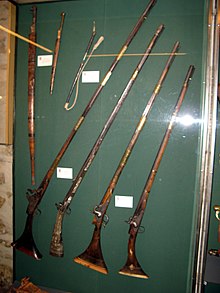Moukahla
| Moukahla | |
|---|---|
 (Left to right)
Moukahla with snaphance lock, Džeferdar with miquelet lock, two moukhala converted to percussion lock. | |
| Type | Musket |
| Service history | |
| In service | 17th to late 19th century |
| Used by | percussion lock (conversion) |
The Moukahla (
widely used in North Africa, produced by many tribes, clans and nations.Mechanism
Lock
Two systems of gunlock prevailed in the Moukahla, one, which derived from Dutch and English types of
Other parts
The caliber of musket ball fired was large, usually in the .67 range. These guns were very long, around 6 feet. The plain barrel alone is 44 to 52 inches in length. The barrel was retained in the stock by about twelve iron, brass, or silver bands (capucines). When silver was used, it was often done in the niello form. These muskets may have all metal work engraved and locks may be covered in sheet silver. The stock and trumpet-shaped butt is typically enhanced by engraved silver shapes inlaid with coral or ivory. Even the exposed parts of the wooden ramrod is encased with silver. [3]
Issues
Issues in the weapon were noted. Although when it was first made, its range was impressive thanks to its long barrel, by the 19th century its range became completely average, and by the 20th century it was completely outdated and short-ranged. It caused a lot of smoke when fired which only cleared after a long time. The majority of these guns did not have bayonets,[4] although organized units such as the Odjak of Algiers, the Odjak of Tunis, and to a certain extent the Black Guard of Morocco did have bayonets equipped.
Origin and usage
These muskets were produced across the Maghreb region, in modern Morocco,[5] Algeria,[6] and Tunisia, where they were the most widespread type of guns. They were so widespread in fact, that every musket was called a moukahla, and european handbooks translated the english word "gun" as moukahla.[7] They were locally produced.[4]
Significance
The Moukahla played a major role in Maghrebi wars up until the early 20th century. It was the most used, and produced musket in the armies of the
References
- ^ Service, United States Army Map (1942). Glossary of Arabic Words Commonly Used on Maps: Prepared Under the Direction of the Chief of Engineers. U.S. Army Map Service.
- ^ Blair: 1982 pages 281,289
- ^ (Blair: 1982 page 289)
- ^ a b c Revue historique des armées (in French). Ministère des armées. 2004.
- ISBN 978-2-7483-2608-6.
- ^ Walmsley, Hugh Mulleneux (1858). Sketches of Algeria During the Kabyle War. Chapman and Hall.
- ^ Cook (Firm), Thomas; Ltd, Thomas Cook (1913). The Traveller's Handbook for Algeria and Tunisia. T. Cook.
- Blair, Claude and Leonid Tarassuk, Editors. The Complete Encyclopedia of Arms and Weapons. New York: 1982
- Elgood, Robert. Firearms of the Islamic World in the Tareg Rajab Museum, Kuwait. London: 1995
See also
- Jezail a similar Afghan weapon
